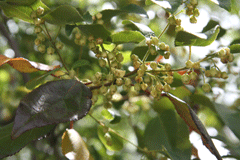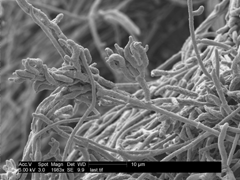Fungal Fuel
Air Date: Week of December 5, 2008

The tree the fungus grows on in the rainforest in Patagonia.
Scientists have discovered a fungus from the Patagonian rainforest that produces hydrocarbons much like those found in diesel fuel. Jessie Martin reports.
Transcript
[COOL FIX THEME]
MARTIN: When you hear the word fungus, you probably think of mushrooms - or the stuff that grows between your toes after walking barefoot in a locker room. But when scientists from Montana State University hear the term fungus, they think of diesel fuel. That’s because they’ve discovered a fungal species that produces hydrocarbons identical to many of those found in diesel. The scientists believe this fungal fuel – or myco-diesel - could be put directly into diesel car engines with little or no need for modification.

Fungus photo taken with a scanning electron microscope. The image is 5000 times the size of the actual fungus.
The fungus was first found in the Patagonia rain forest, where it grows on trees. It feeds on the trees’ organic matter – including cellulose, the part of plants that animals can’t digest - And it turns that cellulose into diesel. That’s exciting news to scientists because cellulose is a major component of every plant on earth and can be grown with minimal input of land, fertilizer and fossil fuels. And while other groups of scientists are working out the details of making ethanol from cellulose, the Montana State team believes that using fungus to make diesel from cellulose will be an easier task.

The tree the fungus grows on in the rainforest in Patagonia.
One small catch is that the researchers aren’t yet sure how efficient the process is. Ultimately, they may end up taking the genes from the fungus and engineering other microbes that could turn cellulose into diesel more efficiently.
In either case, we may soon have to start paying a little more respect to the fungus among us.
That’s this week’s Cool Fix For a Hot Planet. I’m Jessie Martin.
GELLERMAN: And if you have a Cool Fix for a Hot Planet, we'd like to know about it. If we use your idea on the air, we'll send you a sleek electric blue Living on Earth tire gauge. Keep your tires properly inflated and you could save over $280 a year in fuel. That according to a study done at Carnegie Mellon University. Call our listener line at 800-218-99-88, that's 800-218-9988. Or email coolfix—that's one word—at loe.org. That's coolfix@loe.org.
Living on Earth wants to hear from you!
Living on Earth
62 Calef Highway, Suite 212
Lee, NH 03861
Telephone: 617-287-4121
E-mail: comments@loe.org
Newsletter [Click here]
Donate to Living on Earth!
Living on Earth is an independent media program and relies entirely on contributions from listeners and institutions supporting public service. Please donate now to preserve an independent environmental voice.
NewsletterLiving on Earth offers a weekly delivery of the show's rundown to your mailbox. Sign up for our newsletter today!
 Sailors For The Sea: Be the change you want to sea.
Sailors For The Sea: Be the change you want to sea.
 The Grantham Foundation for the Protection of the Environment: Committed to protecting and improving the health of the global environment.
The Grantham Foundation for the Protection of the Environment: Committed to protecting and improving the health of the global environment.
 Contribute to Living on Earth and receive, as our gift to you, an archival print of one of Mark Seth Lender's extraordinary wildlife photographs. Follow the link to see Mark's current collection of photographs.
Contribute to Living on Earth and receive, as our gift to you, an archival print of one of Mark Seth Lender's extraordinary wildlife photographs. Follow the link to see Mark's current collection of photographs.
 Buy a signed copy of Mark Seth Lender's book Smeagull the Seagull & support Living on Earth
Buy a signed copy of Mark Seth Lender's book Smeagull the Seagull & support Living on Earth

